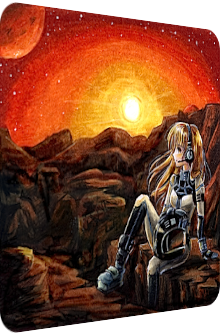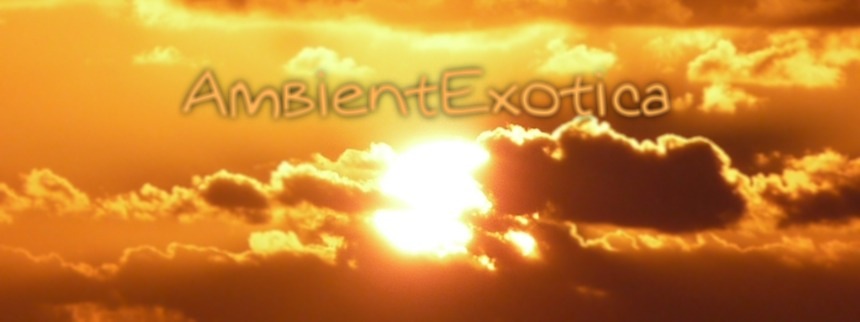
Zoë Blade
Music From Mars
2011
Zoë Blade and her unconditional love for the synth-heavy sounds of the 80's – I stress this stylistic focus in every review of her works, and do it here once more. The London-based producer has visited many places via her music, be it the aquatic water deserts in Hello Calm and the Underwater EP or the hibernal snow-covered fields in Winter. Whatever location is presented on the front covers which are drawn by Aiko aka Javiera Roa Fonseca, the music does not always successfully refer back to the graphical depictions due to the minimalism, purposefully thin layers and rustic 8-bit sound that are so typical for Blade's music. But there is one work that outshines them all. Music From Mars, self-released in March 2011 and available to purchase and listen to in full at Bandcamp is that work. It is different. It is much more successful in its coherence. Music, artwork and concept form a synergy that finally works without any particular flaws… if one can take the strong retro aesthetics that traverse each and every of the eight tracks. The album's first half presents Dance-compatible material with Ambient structures, while the second half is the real deal for Ambient fans since it comprises of either completely beatless structures or soft rhythmic frames. Naturally, Zoë Blade poeticizes life on Mars. She does not create an encapsulating ethereality. Her sound is usually dry, only marginally post-processed and Pop-oriented. As Synth Pop tends to be quite dark and both the theme and the topos suggest a harsher, danger-evoking approach, these feelings are more prominently on her agenda than utopian bliss. But there is a surprising amount of progression found in the calculated minimalism which makes Music From Mars Zoë Blade's most prolific and thriving collection of tracks.
Dark matter pads matter. Hehe. The opener Pusher is a prime example of this assertion, immediately launching with the oxymoronic dry-aqueous duality that is so typical for these bass-fueled acid remnants of the past. The mood is murky, crestfallen, isolated. Soon enough, iridescent stardust waves accompany and lessen the gloomy ambience. But best of all is the delicately retrogressive downbeat which interpolates an 80's Synth Pop feeling. This may be a perfectly common element in Zoë Blade's distinct sound. However, the amount of these unchained long-gone artifacts is tremendously large even for her intrinsic style. Resemblant of C64 shoot 'em up games, Pusher rumbles along, gets perturbed by staccato laser synths and permeated by a threnodic timbre. If you know a few of the artist's works, you know what has been missing thus far but is injected in the song's final stage: male synth choirs which hum along to the clinically sterile arrangement as if it were a space pirate shanty. Pusher is a superb opener that sends shivers down the spines of listeners born between the mid-70's and early 80's, no doubt about that. The following Hopper is a like-minded Rave anthem whose outlook might keep a low profile, but ennobles the construction nonetheless. Mirroring the beginning of the opener, Hopper launches with black hole synth pads and is soon lifted up with the help of arpeggiated synth guitar spirals. Orbital's song Remind of 1992 appears before the inner eye, but Zoë Blade's concoction is genteel and much slower. A 4/4 beat revs up the tension and causes a decrease in shadiness. Pulsating polar chimes, interplanetary laser splinters and gorgeous synth choir bursts underpin the majesty of this anthem. The post-Space-Age sentiment is enormous, the melodies easy to grasp but highly intense. Both Pusher and its next of kin Hopper turn out to be memorable pieces.
The quirky Puddlejumping functions as an anticlimactic comic relief by injecting orbiting whistles, bleeping morse code pulses and a wonky four-note rhythm melody which provides the background for crystalline electro piano quasars. Additional buzzing sounds cover the holes and pauses that occur between each note. The euphoria of the melody slowly rises while this song shifts between a euphonious majesty and space-resembling ornaments of coldness. I do not want to overdo the Orbital connection, but their cheeky track Bath Time off their Blue Album (2004) is a fitting example in regard to its stylistic similarity. Up next is the shortest track of the album which almost crosses the two-minute mark: Faye is a proper Ambient track with churchly organs, downwards spiraling chopped gales and an incomprehensible female voice. It is strictly loop-based which is all the more noticeable due to the omission of a regular beat. All in all, Faye underwhelms on its position. Its textures are warm and ethereal, but the melodies are less successful and the whole arrangement seems rushed. It does, however, provide a change of pace and sounds way less retrograde than the majority of the presented material. The following Dusted moves the pendulum back to the days of yore and depicts a supreme minimalism. Vinyl crackles and blazingly glowing sparkles mark the beginning, but are exchanged with a belly-massaging breakbeat and an attached three-note bass motif. The 90's Eurodance shtick comes to mind, but the beat structure differs strongly. The song closes with a repetition of the bright melody.
Martian Wind is the clear cut centerpiece of the album and an excitingly long track of ten minutes. That it is a progressive Ambient track makes it even better. The song opens with fizzling wind gusts which are quickly pitched down until an apex is reached in the form of a gelid synth stream. This very stream then rises again and morphs back into its windy shape. This motif of undulation is repeated many times, and while it does not sound all too inspiring in written form, let me assure you that the plasticity of the physiognomy is awe-inspiring at higher volume levels. The formulaic frame and the 16-bit aura only ennoble the impetus further. Martian Wind cannot continue like this ad infinitum, and so Zoë Blade places mellow bass droplets of the whimsical kind in the mix and keeps the two-note synth structure of forlorn allusions intact. Admixed square lead gongs and rhythmically wafting fizzles carefully bolster the aural thicket. The second half of the song experiences elastically bouncing acid pipes whose stereo-panned echo conflates with the distance. These particles are the last thing that is heard as they become increasingly diffuse and silky. Martian Wind is a song of epic proportions, at least in the given context. It provides the greatest variety but offers a minimal enough helix to be linked to a hazardous panorama in an alienating world. The clever effect of echoes and reverberations lets the wastelands burgeon, as oxymoronic as this may sound.
The penultimate Geothermal Chamber is undoubtedly the best Ambient track, if only for its humble character. Instead of a cinematic pizzazz, it is based on terrifically warm and snugly two-note synth rivers and sizzling specks, evoking a beatless Detroit scheme. And that's it. The song is pieced together by a sequence of 15 seconds that is looped time and again. Since it is so mellow, organic and shelter-giving, I rate it very highly. The ultimate goal of a loop is to trigger a certain emotion and multiply its intensity. Geothermal Chamber does exactly that. The structure may be farcical, the cavalcade of orange-red color figments, meanwhile, is not. The Ambient outro Coldrum Stones is another fantastic piece. The warmth is increased and is pieced together by one monotonous synth fanfare that is then accentuated by languorous bass bubbles. The interplay between the layers is a bit more complex as new melodies of the same tonal range are introduced, followed by the first signs of chirping birds which then swell to form a lachrymose morning chorus. This clear sign of earthen life might be seen as a counteracting inclusion which does not fit the Mars-related arc of the album, but it is here where Zoë Blade ends the album in a long-term forecast: who says that there won't be a time where birds start chirping on Mars… again?
Music From Mars is Zoë Blade's strongest album I have reviewed so far. The British producer is much more secure in her choices which, luckily enough, are themselves fitting and always compatible with the girdling layers. While I previously questioned the overdose of synth choirs in Hello Calm or the synthetic harps in Winter, I am completely enchanted by the textural qualities and surface-related particularities. The color palette really draws from Martian colors of rusty red and glowing orange, especially so in the latter half of the album. Music From Mars is refreshingly melodious and features the – now seemingly ancient – production techniques of the early 80's. Despite the producer's obvious talent, she falls back to these past synthscapes time and again. Or should I rather say "moves forward"? Indeed I should, for everything works on this album, minimalism and Synth Pop structures mesh harmoniously, the Dance-oriented beats do not degrade the Ambient factor, and the skillful variety of quirkiness, isolation and amicable warmth works throughout the album. Only the short interlude Faye does not work due to its suboptimal melodies, but everything else succeeds, particularly the first complementary acidic Synth Pop couple and the final Ambient duopol. The difference in temperature between these tracks shows the, err, retro-focused progression Zoë Blade undertook over the course of the album. I can wholeheartedly recommend this work as a whole for fans of that 80's sound which would like to unite the crepuscular creepiness of Ennio Morricone's soundtrack of The Thing (1982) with the blue-shimmering C64 nostalgia bubbles. On a side note, Meat Beat Manifesto's plea has now been fulfilled en passant: Mars Needs Women.
Further listening and reading:
- You can purchase and listen to Music From Mars in full via this Bandcamp link.
- Follow Zoë Blade on Twitter: @ZoeBlade.
Ambient Review 201: Zoë Blade – Music From Mars (2011). Originally published on Apr. 3, 2013 at AmbientExotica.com.
